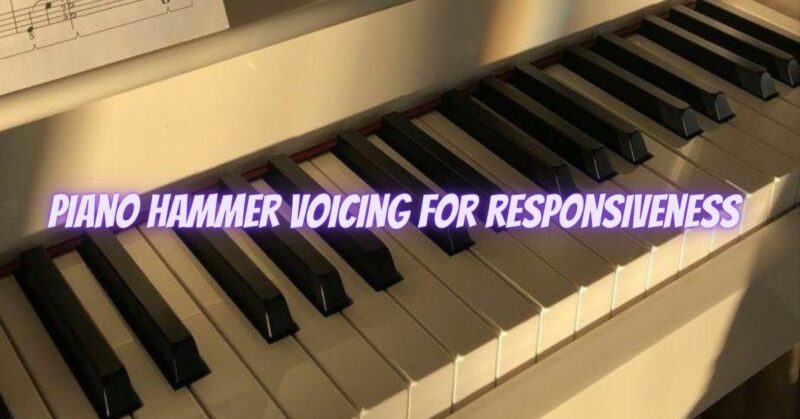One of the essential characteristics of a well-voiced piano is its responsiveness – the ability to quickly and accurately respond to the pianist’s touch. Responsiveness allows the pianist to convey their musical ideas with precision and expressiveness, making the instrument a joy to play. Achieving optimal responsiveness in piano hammer voicing involves careful shaping and conditioning of the hammer felt. Here are some key techniques to enhance the piano’s responsiveness through hammer voicing:
- Hammer Felt Density: The density of the hammer felt plays a crucial role in the piano’s responsiveness. Piano technicians carefully adjust the felt’s density to find the right balance. Dense felt can provide more power and projection, ideal for a responsive touch in fortissimo passages. On the other hand, a less dense felt allows for a more delicate and sensitive response in pianissimo passages.
- Shaping the Hammer Curve: Shaping the hammer curve is another essential aspect of voicing for responsiveness. Technicians carefully mold the hammer felt to ensure it conforms to the shape of the strings. Proper shaping allows the hammers to strike the strings accurately and evenly, promoting a consistent response across all keys.
- Needle Voicing and Needling: Needle voicing involves the precise insertion of voicing needles into the hammer felt. This technique allows technicians to adjust the felt’s density, making it more responsive to the pianist’s touch. The needling process involves inserting needles into specific areas of the hammer felt to soften or harden it as needed.
- Voicing the Strike Point: Voicing the hammer strike point is crucial for achieving responsiveness. Technicians carefully shape the hammer felt’s surface and ensure that the hammers strike the strings at the optimal point for maximum control and sensitivity. Properly voicing the strike point allows the pianist to achieve a broad range of dynamics and tonal colors.
- Fine Adjustment and Listening: Achieving responsiveness in piano hammer voicing requires careful listening and fine adjustments. Both the technician and the pianist work together to evaluate the piano’s response to touch and adjust the voicing accordingly. The technician listens for any inconsistencies in touch and response and makes subtle changes to achieve the desired level of responsiveness.
- Dynamic Range and Control: A well-voiced piano with enhanced responsiveness allows for a broad dynamic range and precise control over the instrument. The pianist can effortlessly navigate through various dynamic levels, from the gentlest pianissimos to powerful fortissimos, with ease and control.
- Consistent Key Levelling: Consistent key levelling is essential for ensuring an even and responsive touch across the entire keyboard. Technicians meticulously level the keys to eliminate any variations that could hinder the piano’s responsiveness.
In conclusion, piano hammer voicing for responsiveness is a delicate and precise process that involves shaping the hammer felt to optimize the instrument’s touch and sensitivity. By carefully adjusting the felt’s density, shaping the hammer curve, voicing the strike point, and collaborating with a skilled piano technician, a pianist can achieve an instrument that responds to their touch with accuracy and expressiveness. A piano with enhanced responsiveness enhances the pianist’s playing experience, enabling them to fully immerse themselves in the music and deliver captivating performances.


